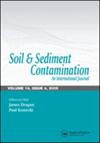Evaluation of 10% minimum elicitation threshold for Cr(VI)‐Induced allergic contact dermatitis using benchmark dose methods
IF 1.5
4区 环境科学与生态学
Q4 ENVIRONMENTAL SCIENCES
引用次数: 3
Abstract
Historical patch test data have been used to propose health‐based soil cleanup levels for Cr(VI) that are protective of eliciting allergic contact dermatitis (ACD) among previously sensitized individuals. Shortcomings regarding the use of these historical studies in the risk assessment of Cr(VI) have been identified and include the use of concentration as the dosimetric for ACD eiicitation rather than the mass per surface area. Information on the surface areas of the patches used by the authors of three of the historical studies have been made available recently, and their dose levels have been converted from units of concentration to mass per surface area. For this study, benchmark dose methods were used to estimate the 10% minimum eiicitation threshold (MET) based on the converted patch test data from these historical studies and from the data presented in a more recent patch test study by Nethercott et ah (1994). A truncated lognonmal model was fitted to the historical data from each individual histori...使用基准剂量法评估Cr(VI)诱导的过敏性接触性皮炎10%最小激发阈值
历史斑贴试验数据已被用于提出基于健康的土壤Cr(VI)清理水平,该水平可保护先前敏感个体引发过敏性接触性皮炎(ACD)。这些历史研究在Cr(VI)风险评估中的缺点已经被发现,包括使用浓度作为ACD排放的剂量计量,而不是每表面积的质量。最近提供了三项历史研究的作者所使用的贴剂的表面面积的资料,其剂量水平已从浓度单位转换为每表面面积的质量。在本研究中,根据这些历史研究的经转换的斑贴试验数据和Nethercott et ah(1994年)最近的斑贴试验研究中提供的数据,使用基准剂量法来估计10%的最小辐射阈值。将截断的对数态模型拟合到每个个体历史数据中。
本文章由计算机程序翻译,如有差异,请以英文原文为准。
求助全文
约1分钟内获得全文
求助全文
来源期刊

Soil & Sediment Contamination
环境科学-环境科学
CiteScore
4.20
自引率
10.00%
发文量
53
审稿时长
2.2 months
期刊介绍:
When it comes to assessing and mitigating contaminated soils and sediments, there is no substitute for having the very latest tools, techniques and methodologies at your fingertips to help you deal with these issues efficiently and cost-effectively.
This is just the kind of essential expertise you’ll only find in Soil and Sediment Contamination . This internationally, peer-reviewed publication focuses on soil and sediment contamination from:
-Sludges-
Petroleum-
Petrochemicals-
Chlorinated hydrocarbons-
Pesticides-
Lead and other heavy metals.
Get detailed descriptions of all the latest and most efficient offsite and in situ remediation techniques, strategies for assessing health effects and hazards, and tips for dealing with everyday regulatory and legal issues. With the state-of-the-art tools that Soil and Sediment Contamination provides, you can successfully assess, mitigate, and solve both rural and urban soil contamination problems as efficiently and economically as possible.
 求助内容:
求助内容: 应助结果提醒方式:
应助结果提醒方式:


